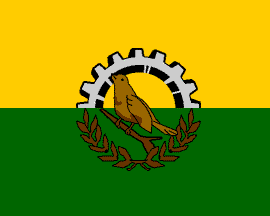
image by Andy Weir, 29 January 2001

Last modified: 2021-08-25 by rob raeside
Keywords: san pedro sula | bird | cortes | thrush | cogwheel |
Links: FOTW homepage |
search |
disclaimer and copyright |
write us |
mirrors

image by Andy Weir, 29 January 2001
See also:
The municipality of San Pedro Sula (549,918 inhabitants in
2000; 837.6 sq. km), located in the eastern part of the valley of
Sula, is the capital of the Department of Cortés. Founded as San
Pedro de Puerto de Caballos, the town was subsequently renamed
San Pedro Sula. The origin of the name of Sula is either the
Aztec word "sol-la", meaning "a place settled by
quails" or the Misquito word "solá", meaning
"deer".
The town of San Pedro Sula was founded on 27 June 1536 by the
Spanish captain Don Pedro de Alvarado. The site of the original
foundation is not known, but it is sure that the settlement had
to be moved several times because of river floods and pirates'
raids. Rich in gold, the town was for years a shleter against the
English, French and Dutch pirates. Virtually abandoned in 1600,
San Pedro had nearly disappeared 60 years later. Until 1860, the
former wealthy town was nothing but a small village mostly used
as a smugglers' camp. The main income of the regular villagers
came from the sale of sarsaparilla (Smilax spp.), then used as a
medicinal herb (namely against psoriasis and syphilis). San Pedro
Sula, which had kept its municipal status re-emerged in the
middle XIXth century when navigation resumed on river Omoa.
On 28 June 1825, the First Honduran Congress decreed
that San Pedro Sula should be incorporated into the Department of
Santa Bárbara, one of the (then) seven departments of Honduras.
On 4 July 1893, General Domingo Vásquez, President of the
Republic, created the Department of Cortés, with San Pedro Sula
as its capital. Still a poor, rural village, San Pedro really
developed after 1902, when concessions were granted to American
companies in northern Honduras to grow bananas. The population of
the town grew from 1,714 in 1888 to 5,000 in 1900 and more than
10,000 in 1920.
In 1949, there were 21,139 inhabitants in San Pedro Sula, which
was the main industrial and trading center of the
country, most of the trade being controlled by foreigners. The
town already had water conveyance, electricity, paved roads and
public transportation. San Pedro Sula is still the second biggest
town in Honduras and its economic capital.
Source: Municipal
website.
Ivan Sache, 15 February 2008
The arms and flag of Cortes Department are the same as its
capital, San Pedro Sula.
Fred Drews, 15 March 2006
The municipal flag of San Pedro Sula was created for the
celebration of the 450th anniversary of the foundation of the
town and presented to the Municipal Council on 10 June 1986.
The flag is horizontally divided yellow-green, with in the middle
a thrush surrounded on the top by a cogwheel and on the bottom by
a laurel branch.
The yellow stripes represents gold, as a symbol of beauty,
nobility, magnanimity, richness, power, light, constancy and
wisdom, which are permanent characteristics of the laborious
citizens of San Pedro. The yellow colour also recalls the strong
religious feelings of the population.
The green stripe symbolizes the beauty and fertility of the
valleys and mountains of the Valley of Sula, the presence of the
love and art of the ancestors, highlighted in the jade of its
most precious jewels. The green colour also symbolizes the hope
that the republic has in this region a hotspot of wealth and
progress powered by the strength of its citizens.
The thrush shown in the middle of the flag symbolizes the spirit
of the inhabitants of the town, which do with constancy their
material and spiritual tasks, while being happy and friendly with
the others. The spirit of the early rising inhabitants is
symbolized by the early song of the thrush.
The cogwheel ("progress' wheel") represents the
permanent effort for the achievement of developpement and the
creation of sources of work in industry, trade and agriculture.
The cogs symbolize the union of the forces and ideas of the
lifeblood ot the town to boost development.
The laurel crown is to be understood as a reward granted only to
the winners. Laurel is the permanent stimulus to the inhabitants
of San Pedro to successfully reach their personal and collective
objectives.
Source: Municipal
website, symbols page
Ivan Sache, 15 February 2008
10.gif)
image by Fred Drews, 12 June 2014
Improved Coat of arms San Pedro Sula, department Cortés.
Fred Drews, 12 June 2014